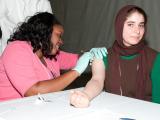"We are not out of the woods yet," said Anne Schuchat, MD, the acting director of the Centers for Disease Control and Prevention (CDC), as she described the rising influenza activity that's swept across the United States.
According to Schuchat, this past week brought yet another increase in influenza-like illness (ILI) activity, a spike in hospitalizations, and, most distressingly, 16 new reports of pediatric influenza deaths. Now 53 pediatric deaths this season have been attributed to the flu.
Schuchat and Dan Jernigan, MD, MPH, director of the influenza division at the CDC's National Center for Immunization and Respiratory Diseases, briefed the media on flu activity today.
Jernigan said that pediatric deaths in past flu seasons have ranged from 37 to 171, with 368 deaths in children reported during the H1N1 pandemic of 2009-10. Jernigan said about half of the children who died this season were healthy prior to their flu infections.
While reports of overcrowded hospitals and closed school districts continue to appear in the news cycle, Jernigan and Schuchat urged parents to monitor sick children closely.
"We of course don't want the worried well to be exposed to flu at a hospital, but if your child has persistent high fever, or if they improve but then get sick again, those are signs it's time to see a provider," said Schuchat.
Hospitalizations surpass 2014-15
The last season as severe as this year's was in 2014-15, but at this point in that season the cumulative hospitalization rate was 43.5 per 100,000 population. This week that number was 51.4 per 100,000 population, according to the latest FluView surveillance data published by the CDC.
The hospitalization rate for those 65 and older was 226.8 per 100,000 population, a jump from the previous week's rate of 183.1 per 100,000 population. Adults aged 50 to 64 were hospitalized at a rate of 54.0 per 100,000 population, and children aged 4 years and younger at 33.3 per 100,000 population.
Despite more reports of influenza B, the vast majority (87.5%) of hospitalized infections were associated with influenza A virus, with 12% associated with influenza B virus, and only 0.2% with influenza A virus and influenza B virus co-infection. H3N2 made up 86.5% of hospitalized influenza A infections.
"H3N2 is still the dominant strain this season," Jernigan. "At this pace, the number of flu hospitalization may exceed the 710,000 seen in 2014-2015."
Yesterday, Canadian researchers released an analysis of mid-season flu vaccine effectiveness, showing that this year's vaccine was performing dismally against H3N2, offering only about 17% protection against that subtype—and even that wasn't a statistically significant finding.
Older people are especially susceptible to severe H3N2 infections, which contributes to the high rate of hospitalization, Jernigan said.
Among all laboratory samples of the flu surveyed by the CDC this week, 80.2% of positive specimens were influenza A, and, of influenza A specimens that were subtyped, 84.3% were H3N2. Almost 20% (19.8%) of samples were influenza B, a strain that becomes more active in the latter half of the flu season.
Neither Jernigan nor Schuchat would speculate whether flu activity was peaking in this, the tenth week of elevated activity. Flu seasons typically last between 11 and 20 weeks.
Increased clinic visits stretch supplies
In another measure of this flu season's pervasiveness, the number of states experiencing high ILI activity increased from 39 to 42. And, after the CDC reported widespread flu in 49 states for 3 straight weeks, the number this week dropped to 48 states, with Oregon reporting regional activity and Hawaii noting local flu activity.
The percentage of outpatients reporting ILI was 7.1%, well above the national baseline of 2.2% and up from 6.6% last week. In 2009, during the peak of the H1N1 pandemic, that percentage was 7.7%. During the 2014-15 season the level peaked at 6.0%.
All of the clinic and hospital visits have stretched medical supplies, including saline products used in intravenous bags and medicine preparations. Many of these products are manufactured in Puerto Rico, and the supply was destroyed during this fall's devastating Hurricane Maria.
Yesterday Scott Gottlieb, MD, the commissioner of the Food and Drug Administration (FDA), issued a statement on these shortages, citing both the severe flu season and Hurricane Maria as the main factors behind the shortage.
"The FDA was able to extend the expiration dates of certain products, including some 500 ml size saline bags, after carefully examining the data submitted by the company to ensure that it meets the FDA's quality and safety standards," Gottlieb said. "We continue to encourage companies to submit data to extend expiration dates for drugs in shortage. We've also been working with manufacturers such as Baxter and B. Braun to import products into the U.S. from their foreign facilities, including most recently additional products from a Baxter facility in Brazil."
Gottlieb said there was no nationwide shortage of antiviral drugs, adding that the FDA was closely monitoring national supplies of antivirals as well as flu vaccines.
See also
Feb 2 CDC FluView
Feb 1 CIDRAP News story "Canadian data show low flu vaccine protection against H3N2"
Feb 1 FDA statement




















